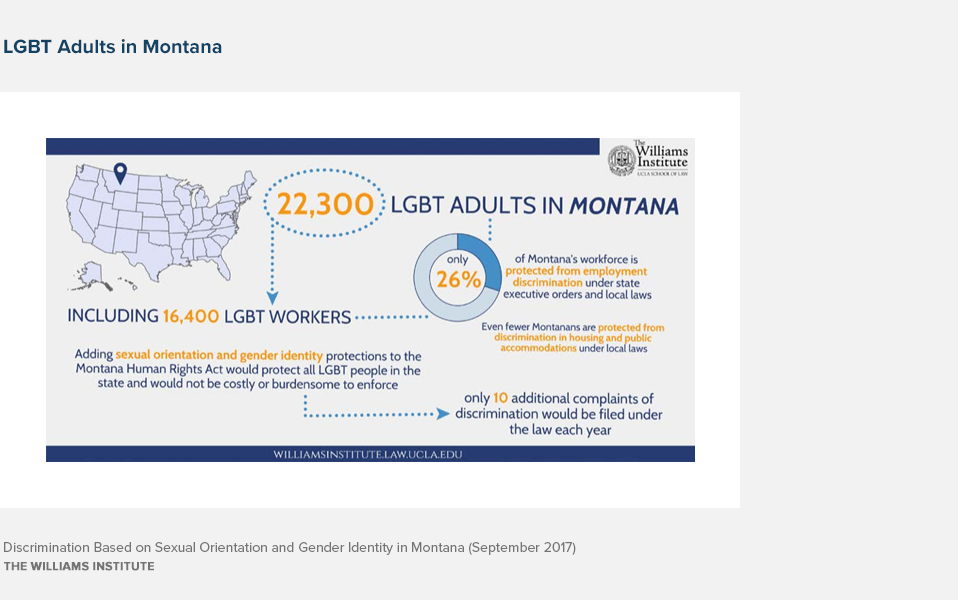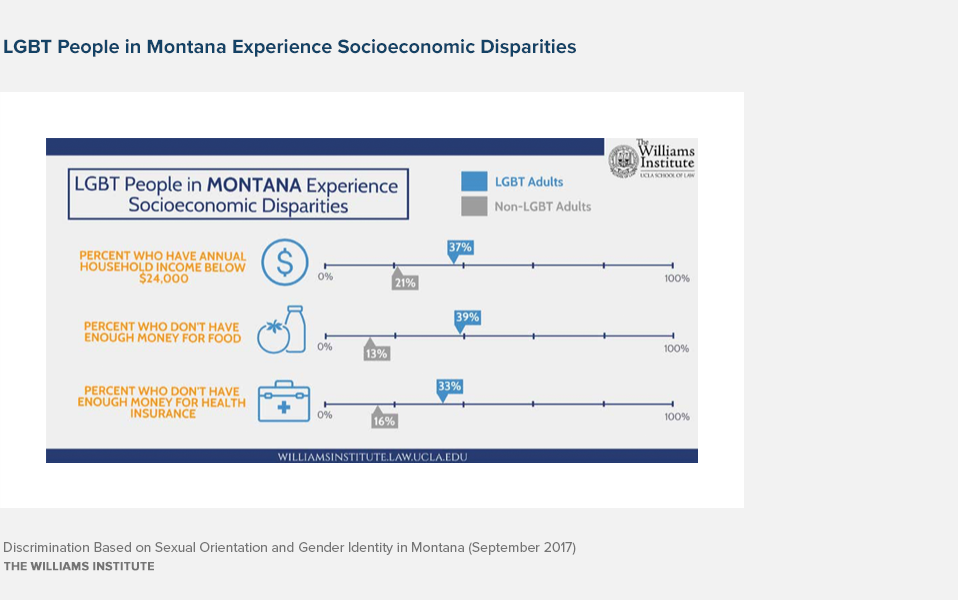Executive Summary
Over 4% of American adults identify as LGBT. Approximately 22,300 LGBT adults live in Montana. Montana does not have a statewide law that expressly prohibits discrimination based on sexual orientation or gender identity.
This report summarizes evidence of sexual orientation and gender identity discrimination in Montana, explains the limited current protections from sexual orientation and gender identity discrimination in the state, and estimates the administrative impact of adding sexual orientation and gender identity to the state’s existing non-discrimination law.
Key Findings
LGBT People in Montana Report Experiencing Discrimination and Harassment in Employment, Housing, Public Accommodations, and Other Settings
- An estimated 22,300 LGBT adults live in Montana. There are over 16,400 LGBT people aged 16 and older in Montana’s workforce.
- Survey data indicate that discrimination against LGBT people occurs in Montana. For example, a survey of Montana State University students found that 26% of LGBTQ students said they had been harassed in classrooms and 53% felt that they had to conceal their sexual orientation or gender identity to avoid harassment or discrimination. And, a 2014 survey conducted by the State of Montana found that 21% of Montana residents surveyed, including LGBT and non-LGBT residents, reported that they had witnessed housing discrimination based on sexual orientation and 14% reported that they had witnessed housing discrimination based on gender identity in the state.
- In addition, aggregated data from two large public opinion polls conducted between 2011 and 2013 found that 79% of Montana residents thought that LGBT people experienced discrimination in the state. Another public opinion poll conducted in 2016 found that 49% of Montana residents thought that gay and lesbian people experienced a lot of discrimination in the U.S. and 51% of Montana residents thought that transgender people experienced a lot of discrimination in the U.S.
- National survey data on discrimination against LGBT people are consistent with data from Montana. For example, a national survey of LGBT people conducted by Pew Research Center in 2013 found that 21% of respondents said that they had been treated unfairly by an employer in hiring, pay, or promotions and 23% said that had received poor service at a restaurant, hotel, or other places of business because of their sexual orientation or gender identity.
- When transgender people are surveyed separately, they report similar or higher levels of discrimination. For example, the 2015 U.S. Transgender Survey, the largest survey of transgender and gender non-conforming people in the U.S. to date, found that 27% of respondents reported being fired, denied a promotion, or not being hired for a job they applied for in the year prior to the survey because of their gender identity; 23% of respondents reported experiencing some form of housing discrimination in the year prior to the survey because of their gender identity, and 31% reported experiencing some form of mistreatment in a place of public accommodation in the year prior to the survey because of their gender identity.
- Reports of discrimination based on sexual orientation and gender identity in Montana have also been documented in administrative complaints, testimony before the state legislature, and the media.
LGBT People in Montana Experience Socioeconomic Disparities
- Research has linked greater socioeconomic disparities for LGBT people to region, a lack of legal protections from discrimination, and less supportive social attitudes toward LGBT people. Data from the Gallup Daily Tracking poll indicate that LGBT people in Montana experience socioeconomic disparities compared to their non-LGBT counterparts:
- 37% of LGBT adults in Montana reported having an annual household income below$24,000 compared to 21% of non-LGBT adults.
- 39% of LGBT adults in Montana reported that they do not have enough money for food compared to 13% of non-LGBT adults.
- 33% of LGBT adults in Montana reported not having enough money to meet their health care needs compared to 16% of non-LGBT adults.
The State Executive Branch, Local Governments, Private Employers, and Public Universities in Montana Have Made Efforts to Protect LGBT People from Discrimination and Harassment, but Coverage is Incomplete
- A state executive order prohibits discrimination based on sexual orientation and gender identity against state government employees and employees of state government contractors in Montana.
- Five localities in Montana – Bozeman, Butte, Helena, Missoula, and Whitefish – have enacted local ordinances that prohibit discrimination based on sexual orientation and gender identity in employment, housing, public accommodations, and other areas.
- Over 26% of Montana’s workforce is protected from employment discrimination based on sexual orientation or gender identity under the state executive order and local non-discrimination ordinances. Approximately 18% of the state’s adult population is covered by local ordinances that prohibit discrimination based on sexual orientation or gender identity in housing and public accommodations.
- At least half of the 20 largest private-sector employers in Montana prohibit employment discrimination based on sexual orientation and gender identity. In addition, the Montana University System prohibits discrimination based on sexual orientation and gender identity throughout its 16 public colleges and universities.
Public Opinion in Montana Supports the Passage of Non-Discrimination Protections for LGBT People
- In response to a national poll conducted in 2011, 76% of those polled in Montana said that Congress should pass a federal law to prohibit employment discrimination based on sexual orientation and gender identity.
- A poll of Montana residents conducted in 2008 found that 58% supported extending the state’s non-discrimination law to protect gay and lesbian people.
A Statewide Law Prohibiting Discrimination Based on Sexual Orientation and Gender Identity in Montana Would Not Be Administratively Burdensome or Costly to Enforce
- Adding sexual orientation and gender identity to the state’s non-discrimination law would result in approximately 10 additional complaints being filed with the Montana Human Rights Bureau each year.
- The additional 10 complaints of discrimination could likely be absorbed into the existing enforcement system with no need for additional staff and negligible costs.
Download the full report

